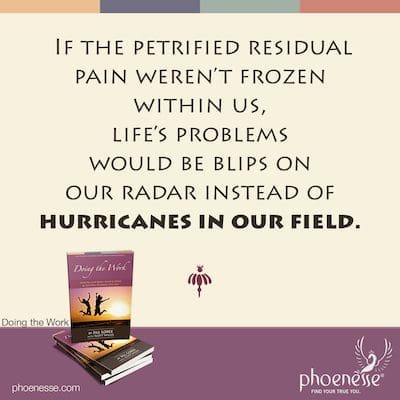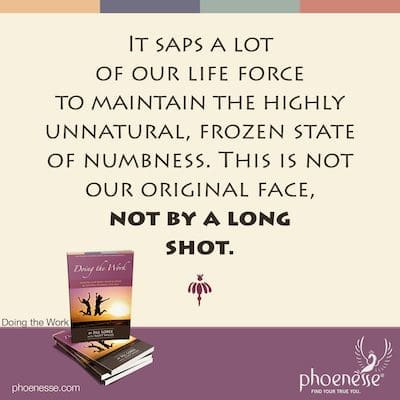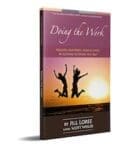I’m Totally Fine, I Feel Nothing

We can divide people who embark on a spiritual path of growth and healing into two camps. There are 1) Those who are abundantly aware that they have painful feelings they would prefer to avoid. These are accompanied by stories from childhood that tell us where the now-residual pain was created in this lifetime. And 2) Those who are not in touch with painful feelings and who just want to be getting more out of life. It’s not that those in the second camp don’t have issues. And it’s not that they won’t surface their work as they go along. But in the moment, they are less aware there was so much lacking in their childhood. Nonetheless, they have an itch for more and they haven’t yet figured out how to scratch it.
In all cases, we have thoughts and feelings inside us we aren’t yet fully aware of. And we have created avoidance strategies designed to keep us safe and help us get our needs met. The only problem with this is that these strategies don’t work. Because they cause us to sidestep the very thing we would most benefit from: taking a good, hard look at our difficulties. And that keeps us spinning in a perpetual state of dissatisfaction.
One of the most universal strategies to know about is our tendency to freeze our feelings. This happens on an energetic level at a very young age, accompanied by the holding of our breath. This is the way a child attempts to block painful feelings it doesn’t have the ability to deal with. It’s a survival mechanism, if you will. But we want to be careful about throwing around claims that “this is what I needed to do to survive.”
The classic thinking of the now-separated inner child aspect is dualistic in nature. Meaning to the child, everything is black or white, good or bad, life or death. It’s true that as children, we didn’t have much in the way of coping skills. But we can terrorize our still-hurting little inner self if we tell tales about how we needed our defenses to save ourselves. Yes, we thought that was true. But in fact, painful feelings are not lethal. We just don’t like them.
So here we can start to realize how the Lower Self uses the helplessness of the fragmented inner child for its own evil purpose of cutting off life. At that time, with our primitive child minds, we thought feeling pain was akin to dying. And we did what we had to do to stay alive. Now, all these years later, these same defenses are firmly and habitually in place, but they no longer save us. More rightly, they no longer serve us at all. Instead, they are now the problem. For they routinely attract experiences that rub raw our old wounds. As a result, they generate additional painful feelings that cause us to turn away from others as though in defense of ourselves.
In fact, the pain we feel now is a mixed bag. It includes new painful feelings, which as adults we have the capacity to feel and move beyond. And also old, old, old residual pain that has gotten stuck. It’s this last bit that causes so much flak in our systems. If the petrified residual pain weren’t frozen within us, life’s problems would be blips on our radar instead of hurricanes in our field.
Here’s where the spirit-mind-body connection comes in. In our spirit, we have soul dents we incarnate to heal. One aspect of this is that in our minds, we harbor faulty conclusions about life that have sunk down out of our conscious awareness. This hidden wrong thinking remains highly charged and so the Lower Self uses it to justify our immature, self-centered behavior and our subsequent efforts to keep ourselves separate from others.
But our bodies are not just along for the ride. They are the vessels, or vehicles, for this journey we’re on. They carry and hold these energetic blocks, which show up in the various ways our bodies armor themselves. There are five basic character structures that result from the wounding which happens at the different stages of child development. (See Spilling the Script for more.)
In our healing sessions, our Helpers will guide us to correlate our feelings with where we are actively storing them and are therefore physically present in our bodies. Where do we hurt? We can learn to identify where the energy is stuck or frozen in our energetic field. For it shows up as pain or tension in our bodies. The way to re-energize these stuck places is to bring awareness—via our breath—into the areas of discomfort, and let the wisdom of our bodies open up and talk to us. (See more in Healing the Hurt: How to Help Using Spiritual Guidance.)
When we breathe into stuck energy, we bring our life force to deadened areas. We created this dead spot because we didn’t want to feel a painful feeling, and guess what: when it wakes up, we’re going to have to feel it now. There will be tears; this is not the end of the world. Quite the opposite, this is the beginning of becoming more alive. The healing water of our tears releases a dam that has been longing for movement.
But before we get into all of this, what we are more apt to notice is…nothing. We numbed our feelings long ago, and until we do the work of freeing up this blocked energy and understanding the false conclusion about life it’s holding onto, we may not feel anything. We need to connect the dots that this stuckness in our beings is what shows up as the feeling we’re stuck in life. It’s one and the same thing.
Successfully cut off from our own selves, the Lower Self has won the hand and put down its cards. Its work is done. But hold on a sec, because lately our Higher Self has been knock, knock, knocking at our inner door, telling us, “Hey, this ain’t it. There’s more to life.” And if we’re consciously walking on a spiritual path, we’ve heard this call. We want more.

Feeling numb feels completely different from feeling clear, or feeling empty. In fact, it saps a lot of our life force to maintain the highly unnatural, frozen state of numbness. This is not our original face, not by a long shot. To be numb is to be deadened and lethargic, and there is a self-perpetuating quality to our desire to do nothing. Further, we get an odd sense of satisfaction from doing things we know aren’t good for us.
This is the pit we have fallen into when we are depressed and feeling hopeless. It may at first seem like it will feel good to let ourselves wallow in darkness and despair, but this is a prison of our own making that we have willfully gone down into. Realizing this may give us some much needed oomph to start stepping our way out.
But recall, we got ourselves here over the course of a long, slow fall and getting ourselves out isn’t going to happen overnight. They don’t hand out vaulting poles for doing this work. In fact, as one might guess by now, there is a spiritual law regarding this: we can’t skip steps. If at some point it seems we’ve finally launched ourselves up and over a lip, this can only be so because we have done the painstaking work of putting one foot in front of the other and didn’t give up.
Numbness is a big hurdle and we must overcome its inertia. We must become willing to undo what we ourselves have done. If we have been hanging out in deep darkness for a long time, we may not even feel we have enough of a foothold in the land of light to cross back over the line. But just as swimming around in the swamp of Lower-Self energies is self-perpetuating, so is tapping into the mother-source of Higher Self strength. Living from our Higher Self can be characterized as living in effortless effort. We become willing to pay the price to have the goodies. And doing so taps us into an everlasting source of wisdom, courage and love that continually replenishes our cup.
We need to take in new information that can help lead us out of the hellish situations we too often find ourselves in. For our true home of heaven lies just around the corner. And as Dorothy discovers in The Wizard of Oz, it’s been right there inside us this whole time, waiting for us to find it.
In Jill’s Experience
On the morning of July 4, 1997, I got one of those phone calls no one ever, ever wants to receive. It was my brother telling me that Sarah, his 18-year-old daughter, had died in a car accident early that morning. Your heart just stops and you know things will never be the same.
Her leaving was a tragedy of immense proportions, but in it there was also a gift. It opened me up in a way I had not been before. To be fair, this didn’t happen right away. I was eight years sober at the time, but still a frozen Popsicle of energy. I was out of the deep freeze but still hadn’t graduated to the refrigerator. So it was several days before I could even feel the pain of her passing and start to cry.
The pain of grief is one that has the ability to heal us in deep places we never thought we’d have to go. And while no one would wish for the experience, I can only say in hindsight that I’m grateful on some level for the passageway that opened when Sarah left.
The morning of her funeral, I sat in the stillness of dawn and looked out over a gently flowing river. With the brand of spirituality under my belt that one absorbs in AA meetings, I had developed a modest rapport with God. But sitting there that morning, I said to no one in particular, “Her spirit has gone to heaven and I have no idea what that means. I want to know.”
Those words resonated through me like the depth charge of a prayer they were. And just one month later I was guided to read my first Pathwork lecture called The Forces of Love, Eros & Sex, as my marriage was as devoid of depth and presence as my childhood had been. And that, it seemed, opened a door to a whole new world.
As I’d worked my way through the Twelve Steps in AA, I had been challenged by the sketchy instructions for undertaking a Fourth Step in which a person takes a “searching and fearless moral inventory.” When I found these teachings from the Guide, it was like I’d discovered an entire library full of directions. A single lifetime could not suffice to work through all that is offered in this miraculous collection. But I got on the stick and started working with a Helper, joined a group, and later went on to become a Helper myself.
Sarah was a light who left this planet way too early. Then again, I honor the Guide’s teachings telling us no one leaves unless, on some level, they have agreed to go. Why she died when she did, I cannot say. But she gave me a monumental gift on her way out for which I owe a deep debt of gratitude. I hope one day, in another lifetime, I will have the chance to repay her.
In Scott’s Experience
I vividly remember the first time I stood up in front of a Pathwork group to process through a difficult situation I was experiencing. The format was that you stood with a Helper in the center of a circle of peers seated around you, and felt the feelings around the situation in question. You go down through the layers of consciousness and feelings until you find the core of the situation.
I had watched other people do it without too much difficulty. Oh, their work was intense to witness sometimes, but the process was straightforward. I stood up… and froze. No amount of coaching me helped. It turns out I wasn’t too good at freely feeling my feelings. I had no idea I was that numb. Who knew?
This brought forward a dilemma: how do you learn to fully feel your feelings if you can’t fully feel? Well, turns out you gently use your positive will. The advice given to me was to state a daily intention to fully feel my feelings, and to pray and ask for help. So in fully intrepid fashion, I did.
I started creating what would become both a deep daily prayer and a tool for setting positive intention for change. I began praying daily to feel my feelings, and like many things, it took some time and persistent positive will. After a few weeks, the dam opened, and I began spontaneously crying a few times a day. It took a while to release the immediate backlog. Eventually the initial gush slowed, but that river had been backed up a long time, and feelings kept bleeding out in a slow steady stream for a year.
Later, I focused on feeling my real feelings. I learned that there are many ways we interrupt, and thus numb, our feelings. Blocking them altogether is the most extreme, but we can also do quite a job manipulating them. I found places where I dampen my feelings. For example, if someone cancels plans on short notice, I might not feel the full depth of disappointment.
I have also found places where I over-amplify feelings. If someone cuts me off in traffic, I might feel outrage instead of what was really just mild annoyance. And I have found places where I substitute one feeling because I didn’t want to feel another. If lust isn’t ok, then I covered it with shame, and then didn’t like that feeling, so I hid it with guilt, and then buried that under anger, finally squishing the anger into the background. It’s much better to simply feel the lust; I have learned that it won’t kill me and it doesn’t mean I have to act on it.
It turned out feeling my real feelings was quite a long journey. It was part of my daily prayers for eight years until I felt like I really got it. That doesn’t mean I was done learning—I am still learning—but by then I had thoroughly established the intention and practice in my life.
Learning to feel my real feelings without manipulating them was the gateway to profound states of feeling alive.
Next Chapter
Return to Doing the Work Contents


